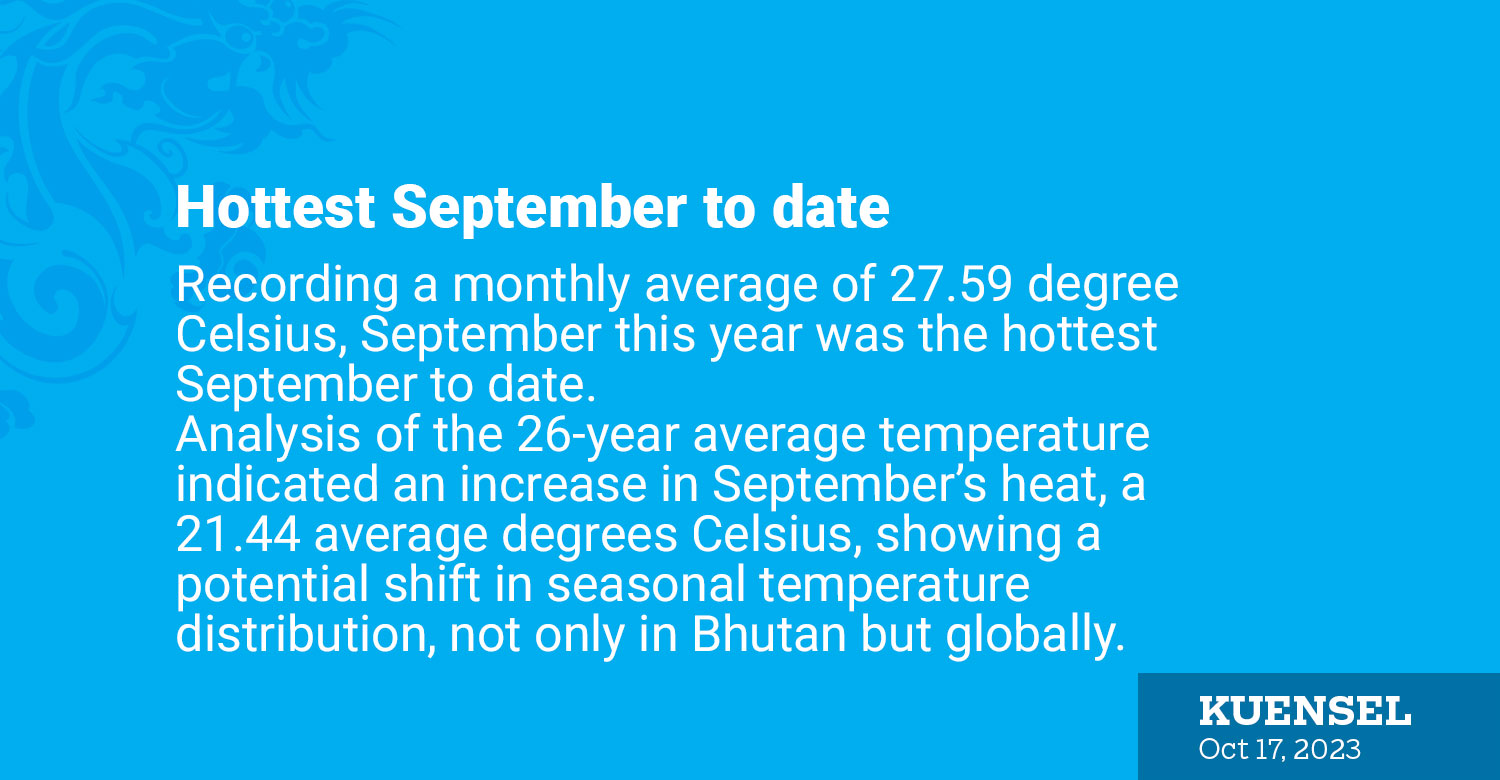Sherab Lhamo
Recording a monthly average of 27.59 degree Celsius, September this year was the hottest September to date.
Analysis of the 26-year average temperature indicated an increase in September’s heat, a 21.44 average degrees Celsius, showing a potential shift in seasonal temperature distribution, not only in Bhutan but globally.
The yearly average of maximum and minimum temperature showed maximum temperature increase while minimum temperature decreased, indicating a growing range of temperatures.
Punakha experienced the most significant rise in temperatures, followed by Pemagatshel, Wanguephodrang, Chamkhar and Zhemgang. Damphu, Gasa, Haa and Semtokha showed a decrease in trend in both maximum and minimum temperature, according to the National Center for Hydrology and Meteorology (NCHM) analysis.
The effect of El Nino, a climatic phenomenon known to trigger erratic weather patterns such as droughts and heavy rainfall, is set to persist throughout 2023 and 2024.
World Meteorological Organisation secretary, Petteri Taalas warned that the warming El Niño event is still developing, and so we can expect these record-breaking temperatures to continue for months, with cascading impacts on our environment and society.
Europe, Africa, North and South America, Asia, including Antarctica and the Arctic had their warmest September on record, according to the National Oceanic and Atmospheric Administration.
“This extreme month has propelled 2023 into the dubious honour of first place –poised to become the warmest year, around 1.4°C suppressing pre-industrial average temperatures,” said Samantha Burgess, Deputy Director of the Copernicus Climate Change Service in a statement.
The underlying cause of it all is global warming causing the emission of greenhouse gases through various activities like fossil fuel burning, vehicle emission and agricultural activities among others.
The effect of El Nino, currently being experienced, has caused seasonal factors to contribute to less than normal monsoon strength in Bhutan.
The International Panel on Climate Change (IPCC) report highlighted the evidence of the rise in the global average temperature, leading to the worsening of various types of disasters.
The major impacts of climate change in Bhutan will be the one on water resources and disaster due to the risk of Glacial Lake Outburst Floods (GLOF) accelerating melting of glaciers, and extreme weather events like heavy rain, droughts, and heat waves, said the NCHM official.
The official added that Hydro-power plants face potential water shortage due to drying up of sources, agricultural claims of damage to crops, and health leading to higher chances of heat strokes, proliferation of disease-carrying insects and others.
Climate change and global warming are not confined by borders, affecting low-emitting regions as much as high-emitting regions. Furthermore, the Himalayan mountain range and its nearby areas are highly vulnerable to the effects of climate change due to its terrain and the presence of many glaciers, said the official.
“Unfortunately, climate change is happening. Things that we said would come to pass are coming to pass, and it will get worse if we continue to emit carbon dioxide and other greenhouse gases into our atmosphere,” said a climate scientist and director of NASA’s Goddard Institute for Space Studies, Gavin Schmidt.
Bhutan has pledged to remain carbon neutral for all times to come at COP 15 and is a net sequester of carbon as the country is absorbing more carbon than it emits. However, there will be emissions contributing to climate change from Bhutan.


